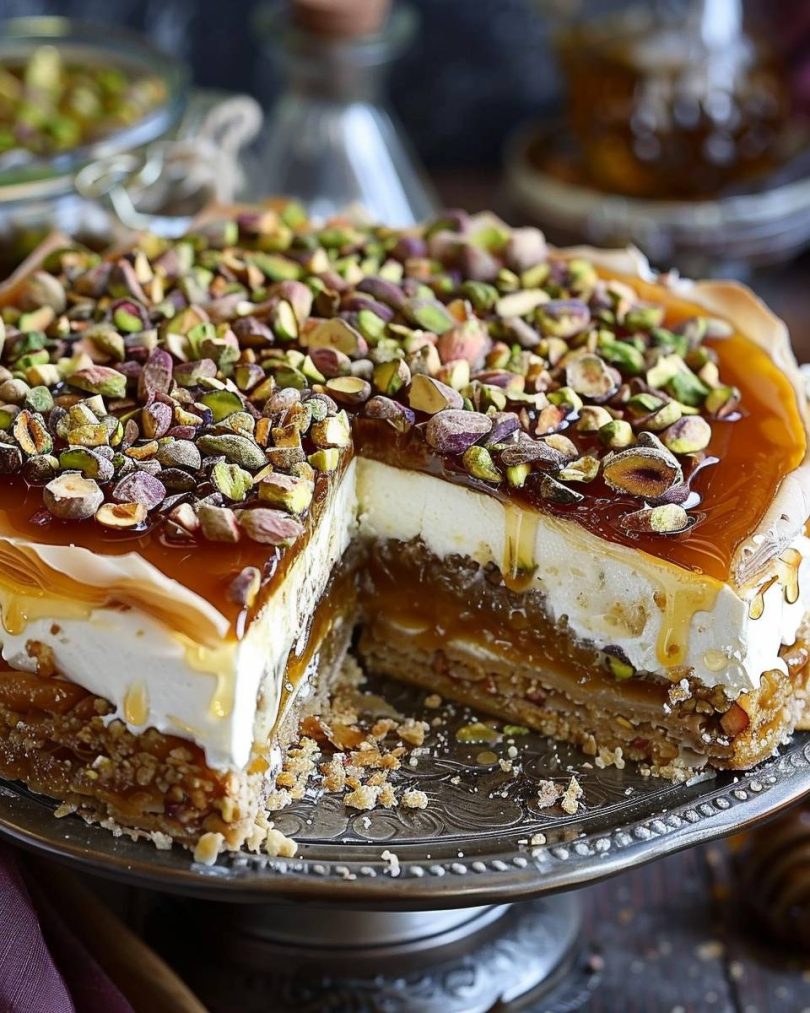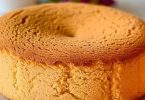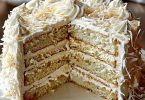Exploring the Rich Heritage and Culinary Fusion of Honey Pistachio Baklava Cheesecake
Honey Pistachio Baklava Cheesecake merges the rich, nutty layers of traditional baklava with the creamy, tangy sweetness of cheesecake. This dessert hybrid not only combines flavors from the Mediterranean and Middle East but also offers a luxurious texture contrast that can elevate any dining experience. The key ingredients—honey, pistachios, and phyllo dough—each play a pivotal role in delivering its distinctive taste and texture. The appeal of this cheesecake variation lies in its intricate composition and the balance of sweet and nutty elements. Perfect for special occasions or as a gourmet dessert option, Honey Pistachio Baklava Cheesecake promises a culinary journey that respects traditional baking while embracing innovative twists.
The Rich History of Baklava
Baklava is a layered pastry delight that is steeped in history, often associated with the luxurious courts of the Ottoman Empire. This exquisite dessert was not merely a sweet treat but also a symbol of wealth and sophistication. According to popular anecdotes, baklava was so revered that it was traditionally prepared for the elite janissary troops as part of a ceremonial tribute known as the Baklava Alayı. This event involved trays of baklava being paraded on horseback through the Topkapi Palace, a grand display of culinary prestige.
Beyond its ceremonial uses, baklava’s layers are rumored to represent the various classes of the empire, from the sultan to the common folk, showcasing the dish’s integral role in cultural symbolism. The perfect preparation of phyllo dough, so thin that “a soldier’s love letter could be read through it,” was considered a true art form mastered by only the finest chefs in the royal kitchens. For those fascinated by its royal connections, the Daily Sabah provides a deeper dive into baklava’s opulent past within Ottoman traditions.
The Ancient Origins of Cheesecake
Cheesecake has its own storied past, with its origins dating back to ancient Greece, long before its popularity in the bustling streets of modern cities. The Greeks considered cheesecake a good source of energy, and it was served to athletes during the first Olympic games in 776 BC—a testament to its esteemed place in Greek culture. By the time the Romans conquered Greece, the simple recipe had been adopted and adapted, enriched with eggs and heated to create a more familiar version of the cheesecake we know today.
This dessert’s journey from ancient Greece through to the Roman Empire highlights a culinary evolution, marked by regional variations and experimental flavors. It’s this spirit of innovation that has carried into the modern era, where cheesecake now serves as a canvas for creative culinary fusion. Today, chefs and home bakers alike delight in adding unique twists to the traditional, and the Honey Pistachio Baklava Cheesecake is a prime example of this trend. Embodying the convergence of two classic desserts, this creation is a testament to the endless possibilities in the world of baking. For more on the fascinating evolution of cheesecake, visit The History of Cheesecake: Who Made it First? which offers an engaging recount of its historical journey and adaptation over centuries.
Step-by-Step Creation of Honey Pistachio Baklava Cheesecake: Ingredients and Recipe Breakdown
As we transition from the rich historical tapestry to the tangible and tasty process of creating a Honey Pistachio Baklava Cheesecake, we bridge the gap between past and present. Drawing inspiration from the legacy of baklava and cheesecake, this recipe is a culinary homage that brings ancient flavors into contemporary kitchens. Each ingredient is chosen not only for its cultural significance but also for its role in crafting a dessert that’s both delicious and visually stunning.
Ingredients:
The journey of creating the Honey Pistachio Baklava Cheesecake begins with a careful selection of ingredients that echo the historical narratives we’ve explored. These ingredients meld to form a dessert that is as delightful to the palate as it is steeped in tradition:
Pistachio and Graham Cracker Crust:
1 1/2 cups (150g) graham cracker crumbs
3/4 cup (100g) finely ground pistachios
1/4 cup (30g) roughly chopped pistachios
1/3 cup (66g) granulated sugar
1/2 cup (113g) unsalted butter, melted
Cheesecake Filling:
17.6 oz (500g) cream cheese, room temperature
1 cup (200g) granulated sugar
Pinch of salt
2 teaspoons (10ml) vanilla extract
1 tablespoon (15ml) lemon zest
1 tablespoon (15ml) lemon juice
1 tablespoon (8g) corn starch
3 large eggs, room temperature
8.8 oz (250g) strained Greek yogurt (or sour cream)
Baklava Topping:
1 package phyllo dough (450g), thawed according to package instructions
1 cup (226g) unsalted butter, melted
1 cup (120g) chopped pistachios
1 cup (340g) honey
1/2 cup (120ml) water
1/2 cup (100g) sugar
1 teaspoon (2g) ground cinnamon
1/2 teaspoon (1g) ground cloves
Step-by-Step Instructions:
With ingredients ready, the next step is the creation process. The recipe unfolds in structured phases, each contributing to the final masterpiece:
Preheat the oven to 350°F (175°C) and lightly grease a 9-inch (23cm) springform pan.
Pistachio and Graham Cracker Crust:
Combine graham cracker crumbs, both finely ground and roughly chopped pistachios, sugar, and melted butter in a bowl.
Press the mixture into the bottom of the prepared pan.
Bake for 10 minutes or until set. Remove from the oven and let it cool.
Cheesecake Filling:
In a large mixing bowl, beat the cream cheese until smooth. Add sugar, salt, vanilla extract, lemon zest, lemon juice, and cornstarch; mix until combined.
Add the eggs one at a time, mixing well after each addition. Fold in the Greek yogurt.
Pour the filling over the cooled crust and smooth the top with a spatula.
Bake for 45-55 minutes or until the cheesecake is set but still slightly wobbly in the center.
Turn off the oven, open the door slightly, and let the cheesecake cool inside for 1 hour. Then remove from the oven and cool to room temperature. Chill in the refrigerator for at least 4 hours.
Baklava Topping:
While the cheesecake is chilling, prepare the syrup by combining honey, water, sugar, cinnamon, and cloves in a saucepan. Bring to a simmer, stirring until sugar is dissolved. Simmer for about 10 minutes until slightly thickened, then let cool.
Carefully lay a sheet of phyllo dough on a clean surface and brush with melted butter. Place another sheet on top and brush with more butter. Sprinkle with chopped pistachios. Repeat this process until you have 8-10 layers, finishing with a layer of butter.
Cut the phyllo stack in a size to fit the top of the cheesecake and bake in the preheated oven at 350°F (175°C) until golden brown, about 15-20 minutes.
Allow the phyllo to cool slightly, then carefully place on top of the chilled cheesecake.
Pour the cooled syrup over the phyllo layer and let it soak in.
Sprinkle additional chopped pistachios over the top for decoration.
Let the completed Honey Cheesecake Pistachio Baklava set in the refrigerator for at least an hour before serving.
Elevating Your Dessert Experience: Serving and Presentation Tips
The final touches on your Honey Pistachio Baklava Cheesecake not only enhance its flavors but also elevate its presentation, making it a showstopper at any gathering. The aesthetic appeal of this dessert is crucial as it reflects the rich history and intricate composition of the ingredients used.
Enhancing Visual Appeal with Toppings: Adding visually appealing toppings to your cheesecake can transform it from a simple dessert to a masterpiece. A generous sprinkle of chopped pistachios over the golden-baked phyllo layer adds a touch of vibrant green that contrasts beautifully with the honey’s amber glow. For an extra touch of luxury, edible gold leaf or finely shredded phyllo dough toasted to golden perfection can be scattered atop before serving. This not only plays up the textures but also nods to the dessert’s opulent Ottoman roots.
Serving Suggestions: When serving Honey Pistachio Baklava Cheesecake, consider the setting. A vintage glass cake stand can enhance the rustic yet refined look of the cheesecake, making it even more inviting. Pairing the cheesecake with a side of lightly spiced chai or a robust Turkish coffee complements its sweet and nutty flavors, providing a harmonious taste experience. Each slice should be served chilled, with a dollop of whipped cream or a drizzle of honey to reinforce the luxurious elements of the dessert.
Storing and Preserving Tips
Ensuring that your Honey Pistachio Baklava Cheesecake maintains its quality and flavor after preparation is as important as the baking process itself. Proper storage not only extends the life of your cheesecake but also preserves its textural integrity and flavor nuances.
Short-term Storage Tips: For short-term storage, keep the cheesecake in the refrigerator covered loosely with foil or plastic wrap to prevent it from absorbing other flavors from the fridge. It’s best to consume the cheesecake within three to four days to enjoy its optimal freshness and texture. Always use a clean knife to cut each slice to prevent the layers from merging and to maintain the crispness of the phyllo topping.
Long-term Freezing Instructions: If you need to store the cheesecake for a longer period, freezing is a viable option. To freeze, first ensure that the cheesecake is completely cooled and set. Wrap it tightly in multiple layers of plastic wrap and then a layer of aluminum foil to protect it from freezer burn. This method can keep your cheesecake fresh for up to two months. When ready to serve, thaw the cheesecake overnight in the refrigerator, not at room temperature, to maintain its structure and flavor.
FAQ Section
Navigating the complexities of making a perfect Honey Pistachio Baklava Cheesecake can bring up numerous questions. Here, we address the most common queries to help ensure your baking success and culinary delight.
Can I Substitute Different Nuts in the Recipe?
Absolutely! While pistachios provide a traditional flavor and a pop of color, other nuts like walnuts, almonds, or pecans can be used as substitutes or in combination to create a different taste profile. Each nut brings its unique flavor and texture, allowing you to customize the cheesecake to your preference.
How Can I Make the Honey Syrup Ahead of Time?
The honey syrup can be prepared up to two weeks in advance. Store it in an airtight container in the refrigerator. When ready to use, gently reheat the syrup to regain a pourable consistency, ensuring it evenly soaks the phyllo layers without making them soggy.
Tips for Freezing and Thawing the Cheesecake for Long-Term Storage:
Freezing the cheesecake properly is crucial for preserving its taste and texture. Wrap the cheesecake securely as described in Part 8. To thaw, place the cheesecake in the refrigerator for at least 24 hours before serving. Avoid thawing at room temperature as it can cause condensation and make the crust soggy.
Why is My Cheesecake Cracking and How Can I Prevent It?
Cheesecake surfaces crack when exposed to sudden temperature changes or if overbaked. To prevent this, ensure a gradual cooling process and consider using a water bath during baking to distribute heat more evenly.
Is There a Vegan Alternative for This Recipe?
For a vegan version, substitute the cream cheese with vegan cream cheese, the butter with a plant-based alternative, and use agar-agar instead of eggs. Ensure all other ingredients like the phyllo dough are vegan-friendly. This adaptation allows everyone to enjoy a version of this delightful dessert.
As we conclude our exploration of creating the exquisite Honey Pistachio Baklava Cheesecake, we hope you feel inspired to embark on this culinary adventure. This dessert not only offers a delightful taste experience but also serves as a bridge connecting diverse cultures through its fusion of baklava and cheesecake. Each slice is a testament to the rich histories and culinary arts of the Mediterranean and Middle Eastern regions, presented through layers of finely crafted flavors and textures.
Embrace the opportunity to dazzle your guests or treat yourself to this luxurious dessert. Whether it becomes a centerpiece at your next gathering or a special treat for a quiet evening, the Honey Pistachio Baklava Cheesecake promises satisfaction and culinary admiration. Dive into the process, experiment with the ingredients, and enjoy each moment of crafting this magnificent dessert. With each step, you’re not just baking—you’re creating a piece of art that’s as enjoyable to look at as it is to eat.






